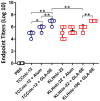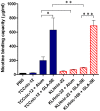Novel Anti-Nicotine Vaccine Using a Trimeric Coiled-Coil Hapten Carrier
- PMID: 25494044
- PMCID: PMC4262398
- DOI: 10.1371/journal.pone.0114366
Novel Anti-Nicotine Vaccine Using a Trimeric Coiled-Coil Hapten Carrier
Abstract
Tobacco addiction represents one of the largest public health problems in the world and is the leading cause of cancer and heart disease, resulting in millions of deaths a year. Vaccines for smoking cessation have shown considerable promise in preclinical models, although functional antibody responses induced in humans are only modestly effective in preventing nicotine entry into the brain. The challenge in generating serum antibodies with a large nicotine binding capacity is made difficult by the fact that this drug is non-immunogenic and must be conjugated as a hapten to a protein carrier. To circumvent the limitations of traditional carriers like keyhole limpet hemocyanin (KLH), we have synthesized a short trimeric coiled-coil peptide (TCC) that creates a series of B and T cell epitopes with uniform stoichiometry and high density. Here we compared the relative activities of a TCC-nic vaccine and two control KLH-nic vaccines using Alum as an adjuvant or GLA-SE, which contains a synthetic TLR4 agonist formulated in a stable oil-in-water emulsion. The results showed that the TCC's high hapten density correlated with a better immune response in mice as measured by anti-nicotine Ab titer, affinity, and specificity, and was responsible for a reduction in anti-carrier immunogenicity. The Ab responses achieved with this synthetic vaccine resulted in a nicotine binding capacity in serum that could prevent >90% of a nicotine dose equivalent to three smoked cigarettes (0.05 mg/kg) from reaching the brain.
Conflict of interest statement
Figures










Similar articles
-
Probing the protective effects of a conformationally constrained nicotine vaccine.Vaccine. 2012 Oct 19;30(47):6665-70. doi: 10.1016/j.vaccine.2012.08.064. Epub 2012 Sep 7. Vaccine. 2012. PMID: 22963803
-
The frequency of early-activated hapten-specific B cell subsets predicts the efficacy of vaccines for nicotine dependence.Vaccine. 2015 Nov 17;33(46):6332-9. doi: 10.1016/j.vaccine.2015.09.015. Epub 2015 Sep 26. Vaccine. 2015. PMID: 26409811 Free PMC article.
-
Selection of a novel anti-nicotine vaccine: influence of antigen design on antibody function in mice.PLoS One. 2013 Oct 1;8(10):e76557. doi: 10.1371/journal.pone.0076557. eCollection 2013. PLoS One. 2013. PMID: 24098532 Free PMC article.
-
New directions in nicotine vaccine design and use.Adv Pharmacol. 2014;69:553-80. doi: 10.1016/B978-0-12-420118-7.00014-7. Adv Pharmacol. 2014. PMID: 24484987 Free PMC article. Review.
-
Vaccination against nicotine: an emerging therapy for tobacco dependence.Expert Opin Investig Drugs. 2007 Nov;16(11):1775-83. doi: 10.1517/13543784.16.11.1775. Expert Opin Investig Drugs. 2007. PMID: 17970637 Review.
Cited by
-
Epitope-targeting platform for broadly protective influenza vaccines.PLoS One. 2021 May 27;16(5):e0252170. doi: 10.1371/journal.pone.0252170. eCollection 2021. PLoS One. 2021. PMID: 34043704 Free PMC article.
-
Rationalization of a nanoparticle-based nicotine nanovaccine as an effective next-generation nicotine vaccine: A focus on hapten localization.Biomaterials. 2017 Sep;138:46-56. doi: 10.1016/j.biomaterials.2017.05.031. Epub 2017 May 19. Biomaterials. 2017. PMID: 28551462 Free PMC article.
-
Effects of a methamphetamine vaccine, IXT-v100, on methamphetamine-related behaviors.Psychopharmacology (Berl). 2020 Mar;237(3):655-667. doi: 10.1007/s00213-019-05399-6. Epub 2019 Nov 22. Psychopharmacology (Berl). 2020. PMID: 31758209
-
A simple physiologically based pharmacokinetic model evaluating the effect of anti-nicotine antibodies on nicotine disposition in the brains of rats and humans.Toxicol Appl Pharmacol. 2016 Sep 15;307:150-164. doi: 10.1016/j.taap.2016.07.017. Epub 2016 Jul 26. Toxicol Appl Pharmacol. 2016. PMID: 27473014 Free PMC article.
-
Peptide-based supramolecular vaccine systems.Acta Biomater. 2021 Oct 1;133:153-167. doi: 10.1016/j.actbio.2021.05.003. Epub 2021 May 16. Acta Biomater. 2021. PMID: 34010691 Free PMC article. Review.
References
-
- (2013) WHO Report on the Global Tobacco Epidemic 2013. World Health Organization.
-
- (2014) The Health Consequences of Smoking—50 Years of Progress: A Report of the Surgeon General, 2014. Rockville, MD: U.S. Department of Health and Human Services.
-
- Stead LF, Perera R, Bullen C, Mant D, Lancaster T (2008) Nicotine replacement therapy for smoking cessation. Cochrane Database Syst Rev: CD000146. - PubMed
Publication types
MeSH terms
Substances
Grants and funding
LinkOut - more resources
Full Text Sources
Other Literature Sources
Medical

